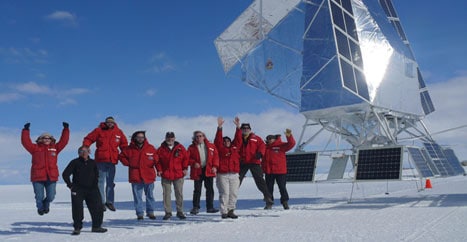
The BLAST team. Credit: Mark Halpern
By Margaret Harris
Things are not going well for the astrophysics “balloonatics” at the bottom of the world. After weeks spent waiting for decent weather, their Balloon-Borne Large Aperture Submilimeter Telescope, or BLAST, has hit a stumbling block. Fairly literally, in fact: the fragile, sensitive instrument has just slammed into the truck being used to launch it. “Oh, you’re (expletive) kidding me,” someone cries in the background, as the stricken telescope sways gently beneath its balloon in the still Antarctic air.
“Step by tedious step, we stumble away from abject failure,” says Barth Netterfield, a Canadian astrophysicist and co-star of the feature-length documentary BLAST, which chronicles the 18 rocky months leading up to the equally rocky launch of the telescope. “And that’s on a good day.” It’s a statement that will bring grimaces of recognition to many an experimentalist’s face, and as a summary of the film, it’s as good as any. If you’re reading this as a PhD student, and your experiment is not going well, take heart: at least it isn’t scattered over a 120-mile stretch of frozen wilderness, with the bulk of it halfway down a crevasse.
Few films about science manage to capture this sort of thing. Both principal investigator Mark Devlin of the University of Pennsylvania and his filmmaker brother Paul are to be commended for including these nitty-gritty details in the film, which is currently making the rounds of independent festivals in Canada (the next showing is at the Whistler Film Festival on 5 December) and elsewhere as part of the International Year of Astronomy in 2009. It’s not all gloomy, either, although there’s a certain gallows humour even in the film’s lighter moments. When an earlier launch in Sweden is plagued by bouts of rain, for example, we see members of the team taking turns to crunch numbers on a “weather calculator”. This is a large foam dartboard with possible launch dates and weather conditions distributed on its surface. The project’s meteorologists are not amused.
Unfortunately, the astrophysical rationale for BLAST gets rather lost along the way. We are told that they are gathering data on very old galaxies, but despite several interludes in which various project scientists attempt to wax lyrical about the early universe, it’s never entirely clear how the various bits of kit attached to the balloon are meant to do this. Because much of the film’s dramatic tension is bound up with wondering whether the project will actually work, there is little room for discussing what the results indicate – if, indeed, they indicate anything at all.
As a duct-tape-festooned chronicle of what real experimental science is like, however, the film is far more interesting than your average wide-eyed astrophysics documentary. As such, the scientific gaps are an annoyance rather than a deal-breaker. BLAST may not live up to its promotional literature (its tag line is “your universe will never be the same”, yet mine is mysteriously unchanged), but it nevertheless offers a fascinating glimpse into life as an astronomer at the ends of the Earth.



